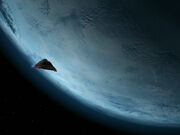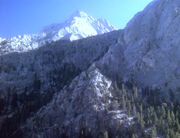No edit summary |
Archer4real (talk | contribs) No edit summary |
||
| (11 intermediate revisions by 7 users not shown) | |||
| Line 1: | Line 1: | ||
| + | {{at|xx}} |
||
| ⚫ | |||
| − | [[File:Class L |
+ | [[File:Orbiting Class L.jpg|thumb|right|The ''Delta Flyer'' orbiting an icy class L planet]] |
| ⚫ | |||
| − | In the [[Federation]] standard system of [[planetary classification]], some barely habitable [[planet]]s and [[moon]]s |
+ | In the [[Federation]] standard system of [[planetary classification]], some barely habitable [[planet]]s, [[planetoid]]s and [[moon]]s were classified as '''Class L'''. A Class L planet had an [[oxygen]]/[[argon]] [[atmosphere]]. A Class L planet contains vegetation, but no animal life. ({{VOY|The 37's}}) |
| − | An example of a Class L planet |
+ | An example of a Class L planet was [[Indri VIII]]. ({{TNG|The Chase}}) |
[[Skalaar]] and [[Jonathan Archer]] landed on a Class L planet in [[2153]] to escape [[Kago-Darr]]. They later landed on it to conduct repairs to Skalaar's [[Tellarite shuttle]]. ({{ENT|Bounty}}) |
[[Skalaar]] and [[Jonathan Archer]] landed on a Class L planet in [[2153]] to escape [[Kago-Darr]]. They later landed on it to conduct repairs to Skalaar's [[Tellarite shuttle]]. ({{ENT|Bounty}}) |
||
| − | The {{USS|Olympia}} crashed on a Class L planet in the [[Rutharian sector]] in [[2371]]. ({{DS9|The Sound of Her Voice}}) |
+ | The {{USS|Olympia}} [[crash landing|crashed]] on a Class L planet in the [[Rutharian sector]] in [[2371]]. ({{DS9|The Sound of Her Voice}}) |
| − | In [[2373]], [[Odo]] and [[Quark]] crash |
+ | In [[2373]], [[Odo]] and [[Quark]] crash landed the {{USS|Rio Grande}} on a Class L [[planet]] after [[Odo]] was traveling with [[Quark]] to meet a [[Federation Grand Jury]]. ({{DS9|The Ascent}}) |
| − | ''In an [[alternate timeline]] in [[2375]], the {{USS|Voyager}} crash |
+ | ''In an [[alternate timeline]] in [[2375]], the {{USS|Voyager}} crash landed on a Class L planet near the border of the [[Alpha Quadrant]].'' ({{VOY|Timeless}}) |
| + | A riddle presented by [[Neelix]] to [[Tuvok]] in [[2376]] contained the story of a [[Starfleet]] [[ensign]], who crash landed on a Class L planetoid. Such planetoids could contain [[Hot spring|hot water springs]]. ({{VOY|Riddles}}) |
||
| ⚫ | [[B'Elanna Torres]] crash landed the ''[[Delta Flyer]]'' on a Class L planet in |
||
| ⚫ | [[B'Elanna Torres]] crash landed the ''[[Delta Flyer]]'' on a Class L planet in 2376 and was stranded there for several days but [[Harry Kim]] finally showed up with the part she needed to contact {{USS|Voyager}} again. This [[Kelis' homeworld|planet]] appeared somewhat atypical of a Class L planet as it contained at least one region that supported lush vegetation and even a [[pre-warp civilization]] known as [[Kelis' species]]. It also produced rain and contained several landmasses and [[ocean]]s or seas. Little was seen of the planet's surface, so perhaps the remainder of the planet was far less hospitable and more standard for a Class L planet. ({{VOY|Muse}}) |
||
| ⚫ | |||
| ⚫ | |||
| ⚫ | |||
| ⚫ | {{bginfo|According to the ''[[Star Trek: Star Charts]]'', on page 25, Class L [[planet]]s were "marginal" planets. They had an age that ranged from four to ten billion years and a diameter between 10,000 and 15,000 [[kilometer]]s. Marginal planets were located within the ecosphere of a [[star system]]. They were categorized by a rocky and barren surface with little surface [[water]] and an atmosphere of oxygen/argon with a high concentration of [[carbon dioxide]]. Native [[lifeform]]s were limited to [[plant]] life, although the majority of Class L planets were suitable for [[humanoid]] [[colony|colonization]].}} |
||
| − | == Background information == |
||
| ⚫ | |||
| ⚫ | According to the ''[[Star Trek: Star Charts]]'', Class L [[planet]]s |
||
[[de:Klasse L]] |
[[de:Klasse L]] |
||
Revision as of 13:07, 11 May 2014
AT: "xx"

The Delta Flyer orbiting an icy class L planet

The surface of a class L planet in the Alpha Quadrant
In the Federation standard system of planetary classification, some barely habitable planets, planetoids and moons were classified as Class L. A Class L planet had an oxygen/argon atmosphere. A Class L planet contains vegetation, but no animal life. (VOY: "The 37's")
An example of a Class L planet was Indri VIII. (TNG: "The Chase")
Skalaar and Jonathan Archer landed on a Class L planet in 2153 to escape Kago-Darr. They later landed on it to conduct repairs to Skalaar's Tellarite shuttle. (ENT: "Bounty")
The USS Olympia crashed on a Class L planet in the Rutharian sector in 2371. (DS9: "The Sound of Her Voice")
In 2373, Odo and Quark crash landed the USS Rio Grande on a Class L planet after Odo was traveling with Quark to meet a Federation Grand Jury. (DS9: "The Ascent")
In an alternate timeline in 2375, the USS Voyager crash landed on a Class L planet near the border of the Alpha Quadrant. (VOY: "Timeless")
A riddle presented by Neelix to Tuvok in 2376 contained the story of a Starfleet ensign, who crash landed on a Class L planetoid. Such planetoids could contain hot water springs. (VOY: "Riddles")
B'Elanna Torres crash landed the Delta Flyer on a Class L planet in 2376 and was stranded there for several days but Harry Kim finally showed up with the part she needed to contact USS Voyager again. This planet appeared somewhat atypical of a Class L planet as it contained at least one region that supported lush vegetation and even a pre-warp civilization known as Kelis' species. It also produced rain and contained several landmasses and oceans or seas. Little was seen of the planet's surface, so perhaps the remainder of the planet was far less hospitable and more standard for a Class L planet. (VOY: "Muse")
In 2378, a Class L planet was found by Hierarchy members Nar and Zet as a settlement site for the crew of the USS Voyager after they confiscated their warp core. (VOY: "Renaissance Man")
| Planetary classification |
|---|
| B • D • G • H • J • K • L • M • N • R • T • Y • Other classes |
